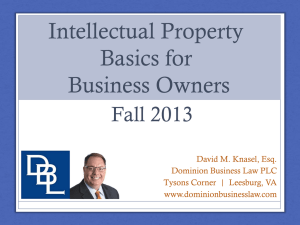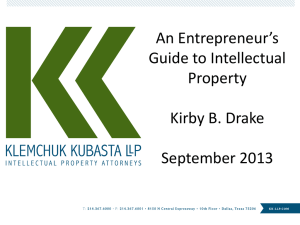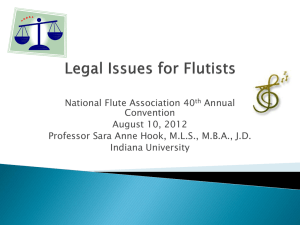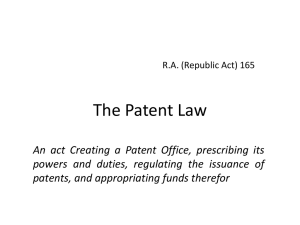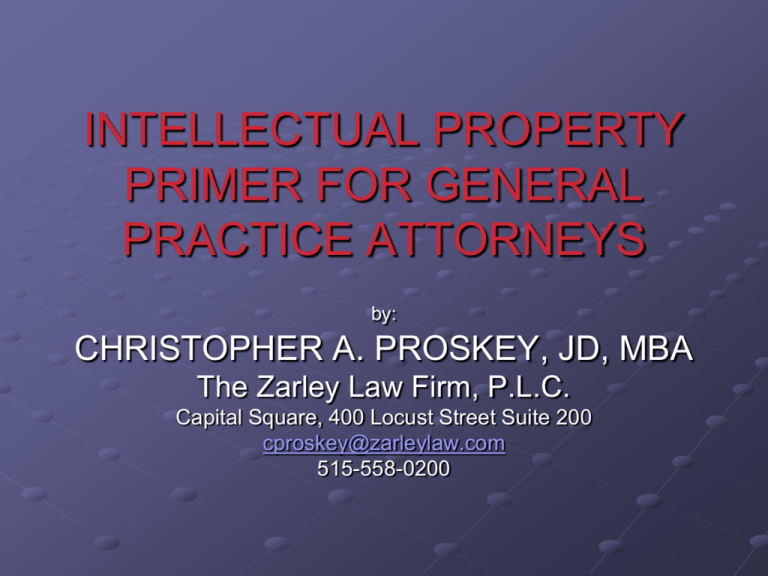
INTELLECTUAL PROPERTY
PRIMER FOR GENERAL
PRACTICE ATTORNEYS
by:
CHRISTOPHER A. PROSKEY, JD, MBA
The Zarley Law Firm, P.L.C.
Capital Square, 400 Locust Street Suite 200
cproskey@zarleylaw.com
515-558-0200
IP - Defined
“Cows come this week!”
“I hated this rock!
Soon to be in the creek!”
IP - Defined
What isn’t Intellectual Property
Anything you can touch, eat, walk on….
What is Intellectual Property:
Ideational creation of the mind for which an
exclusive set of rights are recognized.
Rights reserved for the owner or inventor
Inherently must be protected by the law(s)
Claim 1 – Patent Infringement
Claim 1 – Patent Infringement
What is a Patent
A grant by the government that gives the
creator of an invention the sole right to MAKE,
USE or SELL that invention in that country for
a set period of time.
US = 20-years from the date of filing of the Patent
Application
You must file for a patent in EACH country you
want protection in
Claim 1 – Patent Infringement
• How do you get a Patent?
Patent
Attorney =
Patent
Agent =
Applied
Sciences
Degree
Applied
Sciences
Degree
+
+
Law
School
Pass
Patent
Bar
+
Pass Any
State’s Bar
+
Pass
Patent
Bar
Claim 1 – Patent Infringement
Standard for Patentability:
Anything that is:
New
– 35 U.S.C. § 101; § 102
Useful
– 35 U.S.C. § 101; § 102
Nonobvious
– 35 U.S.C. § 103
Terms of Art – Be Careful!!!
Gilbert Lowell & Lewis Skolnick
Claim 1 - Patent Infringement
But what can you get a Patent on?
35 U.S.C. § 101
You can get a patent on any New, Useful & Nonobvious:
Process
Machine
Manufacture
Composition of Matter
Any New & Useful Improvement Thereof
This now includes:
Plants
Animals
Business Methods
Claim 1 – Patent Infringement
What is Required in a Patent ?
35 U.S.C. § 112 – DISCLOSURE!!!!!!
You get a guaranteed monopoly for 20 years but you
must give up the family jewels
Written description.
Manner and process of making and using it.
Clear, concise and exact terms.
Must enable any person skilled in the art to practice the
invention.
Shall set forth best mode.
Conclude with claim[s] particularly pointing out and distinctly
claiming the subject matter.
Does not need to be an instruction manual.
Claim 1 – Patent Infringement
Anatomy of a Patent
Cover Page
Drawings
Background of the
Invention
Summary of the
Invention
Description of the
Drawings
Detailed Description of
the Invention
Claims
Claim 1 – Patent Infringement
The Name of the Game is the Claim!!!
The claims define the “metes and bounds” of the patent.
Like describing the border around your property.
Claim 1 – Patent Infringement
When do you get a Patent?
One Year Bar! - 35 U.S.C. § 102
You have one year from any public use, public sale, offer for
sale.
The clock does not start to tick if you are legitimately
experimenting – but you have to prove it.
The clock starts to tick when your invention is “ready for
patenting”
Case law allows for experimentation
The earlier you start the process the better.
Should you choose not to patent your invention – you are forced to
elect TRADE SECRET protection!
Claim 1 – Patent Infringement
How much does a Patent cost?
Depending on the complexity - Drafting & Filing a Patent Application
can cost anywhere from $3,500 to $10,000, or more.
How long does it take to get a Patent?
The patenting process can take anywhere from 2-10 years.
Claim 1 – Patent Infringement
Patent Infringement occurs when you:
Make
Use
Sell,
Offer For Sale, or
Import
something that meets Each-and-Every
Limitation of 1 claim of a patent
Claim 2 – Copyright Infringement
Claim 2 – Copyright Infringement
What is a Copyright?
The legal right granted to an author, composer,
playwright, publisher, or distributor to exclusive:
publication,
production,
sale, or
distribution of a
literary,
musical,
dramatic, or
artistic work.
Standard for Copyrightability:
any "original work of authorship" that is
"fixed in a tangible medium of expression."
It does not extend to ideas or concepts.
Claim 2 – Copyright Infringement
37 C.F.R. § 202.1(a) prohibits copyright of a
single word, title or small group of words or
phrases, regardless of originality
Planesi v. Peters, 2005 WL 1939885 (9th Cir. 2005) No. 05-781.
Individual words and short phrases are
generally reserved for Trademarks
Claim 2 – Copyright Infringement
When do you get a CopyRIGHT.
Automatic and instantaneous the moment the
"original work of authorship“ is "fixed in a
tangible medium of expression."
This is a Common Law Copyright
To get a Federally Registered Copyright –
must file a copyright registration with the
United States Copyright Office
Claim 2 – Copyright Infringement
Advantages of Federal Copyright Registration :
Establishes a public record of your copyright.
Your copyright must be registered in order sue for infringement.
If registered within 5-years of publication, your registration certificate
is prima facie evidence of the validity of your copyright.
If registered within 3-months of publication or before an infringement
occurs, once proven, statutory damages of up to $150,000 plus
attorney's fees could be awarded to you as copyright owner, even if
your actual damages are minimal.
Registration deters potential infringement.
If you don't register your copyright and someone else claims your
work as their own, you will have to prove that it is actually yours.
Claim 2 – Copyright Infringement
Copyright Notice:
© Zarley Law Firm 2011
Now Optional – but always good idea!
© Zarley Law Firm 2009 - 2011 - All Rights Reserved
Claim 2 – Copyright Infringement
Term of a Copyright:
70 years after the death of the author
For a Work Made For Hire - 120 years after
creation or 95 years after publication,
whichever is shorter.
Claim 2 – Copyright Infringement
Fair Use Doctrine - 17 U.S.C. § 107:
Permits some copying and distribution without permission of or
payment to the copyright holder. Does not clearly define fair use,
gives four non-exclusive factors to consider in a fair use analysis.
1.
2.
3.
4.
the purpose and character of the use;
the nature of the copyrighted work;
the amount and substantialness of the portion used in
relation to
the copyrighted work as a whole; and
the effect of the use upon the potential market for or value of the
copyrighted work.
Claim 2 – Copyright Infringement
Fair Use – Continued
Excerpts in a review or criticism for illustration or comment;
Quotation in scholarly or technical work;
Use in a parody;
Use in a news report;
Reproduction of a portion to replace part of a damaged copy;
Use by a teacher or student to illustrate an educational lesson;
Reproduction for legislative or judicial proceedings;
Incidental and fortuitous reproduction, in a newsreel or broadcast, of
a work located in the scene of an event being reported.
(1961 Report of the Register of Copyrights on the General Revision of the U.S.
Copyright Law)
Claim 2 – Copyright Infringement
Standard For Copyright Infringement
Whether Defendant copied protected expression in Plaintiff’s
copyrighted work
Look to Fair Use as a defense.
Independent Creation: Defendant’s independent creation of the work
without reliance on Plaintiff’s copyrighted work is a strong defense
Claim 2 – Copyright Infringement
Derivative Work 17 U.S.C. § 101
A “derivative work” is a work based upon one or more pre-existing
works, such as a translation, musical arrangement, dramatization,
fictionalization, motion picture version, sound recording, art
reproduction, abridgment, condensation, or any other form in which
a work may be recast, transformed, or adapted. A work consisting of
editorial revisions, annotations, elaborations, or other modifications
which, as a whole, represent an original work of art.
Claim 3 – Trademark Infringement
Claim 3 – Trademark Infringement
What is a Trademark? The Lanham Act 15 U.S.C. § 1051 et seq.
Any name, symbol, figure, letter, word, or mark
adopted and used by a manufacturer or merchant
in order to designate his or her goods and to
distinguish them from those manufactured or sold
by others.
A Trademark is an indication of source!
Claim 3 – Trademark Infringement
What can you get a Trademark on?
• Any unique indication of source that will not
confuse consumers about affiliations or deceive
consumers regarding qualities, including:
•
•
•
•
•
Colors
Names
Sounds
Smells
Symbols
Claim 3 – Trademark Infringement
How do you get a Trademark?
• Common Law Trademark Rights:
•
Acquired simply by using the mark in commerce!
• Federally Registered Trademark?
•
Must file a trademark application with the USPTO
• Cost = ~$1,000 to $1,500 to file a trademark application.
Claim 3 – Trademark Infringement
Registered Trademark v. Common Law Trademark:
• Unregistered Mark: use “TM” or “SM”
• Registered Mark: use ®
• Owner of unregistered marks can still sue to
prevent unauthorized use of trademark under the
Lanham Act – enforcement is geographically limited
• Registration freezes all other common law users
Claim 3 – Trademark Infringement
Standard for Trademark Infringement
• Likelihood of consumer confusion - Factors
1.
2.
3.
4.
5.
6.
Strength of the mark
Proximity of the goods
Similarity of the marks
Evidence of actual confusion
Marketing channels used
Type of goods and the degree of care likely to be exercised by the
purchaser
7. Defendant's intent in selecting the mark
8. Likelihood of expansion of the product lines
•
AMF, Inc v Sleekcraft Boats, 599 F.2d 341 (C.A.9) 1979.
Claim 4 – Trade Secret Misappropriation
Claim 4 – Trade Secret Misappropriation
What is a Trade Secret? – Iowa Code Chapter 550.2
formula,
pattern,
compilation,
program,
device,
method,
technique, or
process – That:
(1) Derives economic value from not being generally known to the
public, and
(2) Is the subject of reasonable efforts to maintain its secrecy.
Claim 4 – Trade Secret Misappropriation
Examples of a Trade Secret?
Anything where you can sell your product but keep the
family jewels!
KFC’s 12 spices
Formula for Coke-a-Cola
Dr. Pepper’s 23 flavors
Many product’s manufacturing processes
Claim 4 – Trade Secret Misappropriation
What is Trade Secret Misappropriation? – Iowa Code Chapter 550.2
Doing any of the following:
Acquisition by a person who knows that the trade secret is acquired by improper
means.
Disclosure or use by a person who uses improper means to acquire the trade secret.
Disclosure or use by a person who at the time of disclosure or use, knows that the
trade secret is derived from or through a person who had utilized improper means to
acquire the trade secret.
Disclosure or use by a person who at the time of disclosure or use knows that the trade
secret is acquired under circumstances giving rise to a duty to maintain its secrecy or
limit its use.
Disclosure or use by a person who at the time of disclosure or use knows that the trade
secret is derived from or through a person who owes a duty to maintain the trade
secret's secrecy or limit its use.
Disclosure or use by a person who, before a material change in the person's position,
knows that the information is a trade secret and that the trade secret has been
acquired by accident or mistake.
Claim 4 – Trade Secret Misappropriation
How do you protect a Trade Secret?
Put reasonable procedures and processes in place:
Use Non-Disclosure Agreements
Use Non-Competition Agreements
Mark documents confidential
Develop employee training and handbooks regarding the proper
handling of trade secret information
Limit access to trade secret information to those that need-to-know
Be proactive in protecting your trade secrets
Once you let it out of the box – it can’t be put back in
Claim 5 – Unfair Competition
Claim 5 – Unfair Competition
What is Unfair Competition? 15 U.S.C. § 1125(a) Lanham Act
Somewhat the catchall or smell-test provision of IP law:
"false or misleading description of fact, or false or misleading
representation of fact" in commerce, which "is likely to cause
confusion, or to cause mistake, or to deceive as to the affiliation,
connection, or association of such person with another person, or as
to the origin, sponsorship, or approval of his or her goods, services,
or commercial activities by another person.
Includes:
Passing Off
False Advertising
Claim 5 – Unfair Competition
Passing Off 15 U.S.C. § 1125(a) Lanham Act
"(1) an association of origin by the consumer between the
mark and the first user, and
(2) a likelihood of consumer confusion when the mark is
applied to the second user's good(s).
Claim 5 – Unfair Competition
False Advertising 15 U.S.C. § 1125(a) Lanham Act
Plaintiff must show
(1) the challenged statement is literally false or, even
though the statement is not literally false, that it is
likely to deceive or confuse customers, and
(2) the defendant's false or misleading representation
was material in the sense that it would have some
effect on the consumers who are making the
purchasing decision.
Claim 6 – Trade Dress
Claim 6 – Trade Dress
What is Trade Dress? -
15 U.S.C. § 1125(a) Lanham Act
Characteristics of the visual appearance of a
product or its packaging (or even the design of a
building) that signify the source of the product to
consumers
Protected under § 43(a) of the Lanham Act
Features do not need to be registered to be enforced
Features must NOT be functional!!!
Protecting functionality is reserved for patents.
Claim 6 – Trade Dress
What is Trade Dress? -
15 U.S.C. § 1125(a) Lanham Act
Two Pesos, 112 S.Ct. 2753 - protected unique look, feel, decoration
& design of a Mexican restaurant.
Ciba-Geigy Corp., 547 F.Supp. 1095 (D.N.J. 1982) - Protected
blue/white, pink/whit colors of a pill
Ex parte Haig & Haig Ltd., 118 U.S.P.Q. 229 (Comr. Pats 1958) protected distinctive pinched shape of a Scotch bottle
Ferrari SpA v. McBurnie, 11 U.S.P.Q. 2d 1843 (S.D. Cal. 1989) protected shape of Ferrari car from becoming a toy
Unsolicited Advice
Before your client goes into any new area or line of
business consider Claims 1-6. Who will they
upset, who will they take business from, and
what alleged IP rights will your client potentially
be stepping on?
The End!
Questions?
by:
CHRISTOPHER A. PROSKEY, JD, MBA
The Zarley Law Firm, P.L.C.
Capital Square, 400 Locust Street Suite 200
cproskey@zarleylaw.com
515-558-0200

